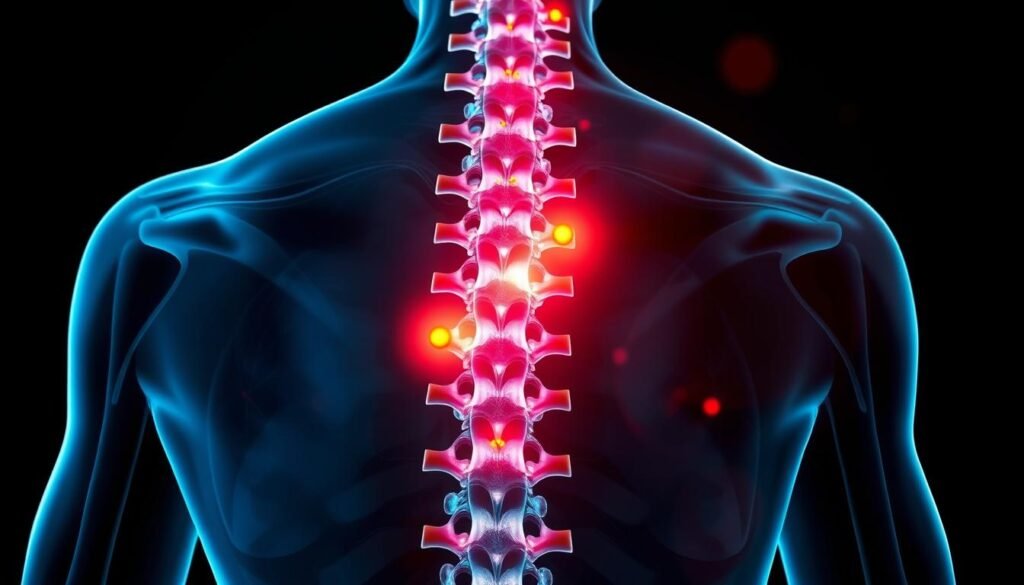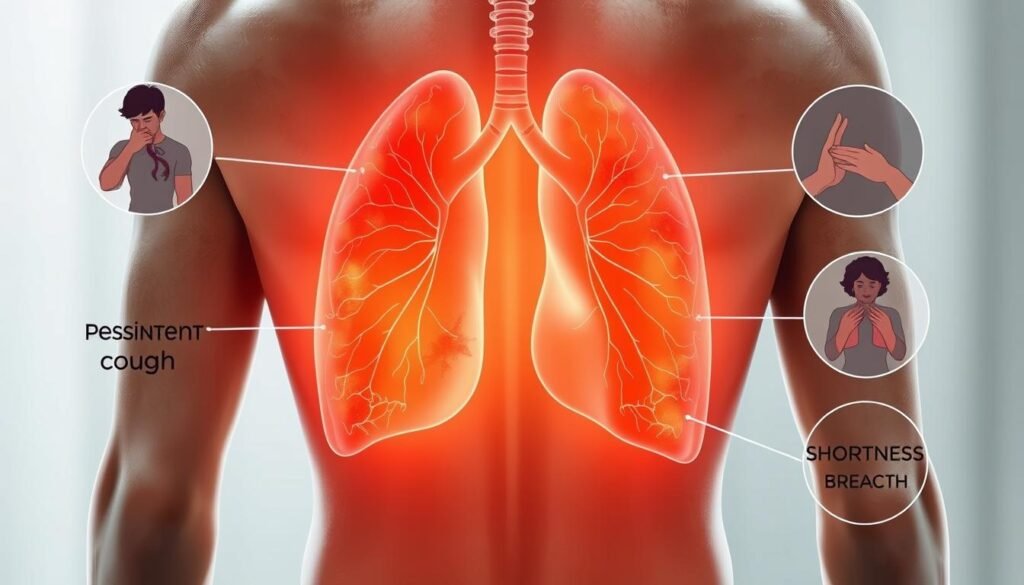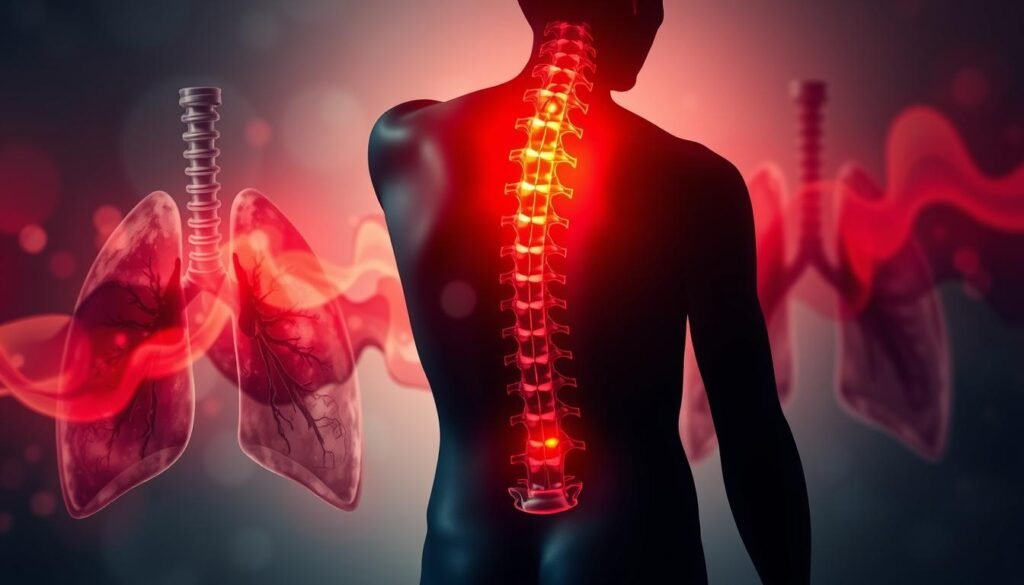About 25% of people with lung cancer feel lower back pain early on. This fact is very important. It shows how crucial it is to notice early warning signs of lung cancer. Often, this pain leads them to seek medical help, where they may find out they have lung cancer.
It’s key to know the signs linked to lower back pain and lung cancer. This knowledge can help catch the disease early. Signs to watch for include unexplained or worsening back pain. This is especially true if there’s also a persistent cough, trouble breathing, or blood when coughing.
Key Takeaways
- About 25% of lung cancer patients experience lower back pain.
- Recognizing early symptoms is crucial for lung cancer detection.
- Back pain can be a key warning sign when combined with respiratory symptoms.
- Understanding the relationship between lung cancer and back pain can improve patient outcomes.
- Timely medical advice can lead to better management of associated symptoms.
Understanding Lower Back Pain
Many people suffer from lower back pain. It comes from different causes, including certain conditions and injuries. Knowing the common causes is key to handling it well.
Common Causes of Lower Back Pain
Lower back pain can happen for many reasons. Muscle strain and herniated discs are common. Muscle strain often happens from lifting heavy things or sudden movements. This can cause inflammation and pain, affecting daily life.
Herniated discs happen when a disc’s inner part presses on nerves. This can cause severe pain, tingling, or numbness going down the legs.
Muscle Strain and Herniated Discs
Other causes of lower back pain include spinal stenosis and physical injuries. Sometimes, lower back pain might point to serious conditions like lung cancer. This is especially true if the pain gets worse or doesn’t go away. If someone suddenly feels pain, coughs up blood, or loses weight without trying, they should see a doctor right away.
The Link Between Lung Cancer and Back Pain
Back pain can sometimes be a red flag for serious health problems, including lung cancer. It’s not often seen as a primary symptom, but its link to lung cancer is important. When tumors spread to the spine, it can cause a lot of pain. About 19% of lung cancer patients go through this, showing why it’s key to know about it.
Spinal Metastasis and Back Pain
Lung cancer can move to the spine, a process called spinal metastasis. This can make back pain severe and constant. If tumors push on spinal nerves, it might also lead to numbness or weakness. Some 30% to 40% of people with a certain lung cancer will face this. It shows why keeping an eye on back pain is essential for anyone diagnosed with lung cancer.
How Lung Cancer Can Affect the Spine
Lung cancer can attack the spine by invading its bone structures. It often targets specific areas of the spine. While back pain may not always be a sign of lung cancer, sometimes it’s the only clue. Figuring it out usually needs special tests like X-rays or MRIs. This helps tell if the pain is from cancer or other issues, such as muscle strain. For more details on how these two are connected, read the full story here.

Identifying Symptoms of Lung Cancer
Recognizing lung cancer symptoms early is key to getting the right treatment. Knowing what symptoms to look for helps people get help sooner. These are the main symptoms to watch out for:
Common Symptoms to Watch For
- Persistent cough: About half of the people with lung cancer have this symptom.
- Coughing up blood (hemoptysis): Seen in about 20% of cases, often early on.
- Weight loss: A significant number of patients lose weight without trying before they’re diagnosed.
- Shortness of breath and chest pain: These symptoms usually happen as the cancer grows.
- Fatigue and persistent infections may also occur.
Specific Symptoms Associated with Back Pain
Back pain with lung cancer is concerning. It’s different from regular back pain. Lung cancer-related back pain should be noted if it:
- Deep aching in the back gets worse at night.
- Causes discomfort that spreads down the legs. This might mean the cancer is spreading.
- Changes in pain levels tie in with other lung cancer symptoms showing up.
If you have these symptoms, consider getting checked out early. Paying attention to your health leads to early treatment, which can improve your situation.

Lower Back Pain and Lung Cancer: Warning Signs
Lower back pain can be a big warning sign of different health problems, like lung cancer. Studies have found that 1 in 4 people with lung cancer have this pain. This pain means the cancer might be growing, reaching the spine, or pressing on nerves.
It’s key for patients to watch out for more signs such as always feeling tired, losing weight, and coughing a lot. These could mean the lung cancer is in a late stage. If the back pain is sudden, very bad, or if there is weakness or numb feeling, it’s very important to get medical help. Such signs could mean there are serious issues like the spinal cord being squeezed.
When lung cancer moves to the spine, it can harm the bones and cause more pain. Sometimes, patients might have high blood calcium levels, making the back pain worse. There are ways to help manage this pain, including pain relievers and special treatments for bone pain.
| Symptom | Description |
|---|---|
| Lower Back Pain | Commonly reported by lung cancer patients; can indicate metastasis to the spine. |
| Spinal Cord Compression | Occurs when lung cancer presses on the spinal cord, leading to pain and mobility issues. |
| Leptomeningeal Metastasis | Slightly rare, but possible; indicates cancer spread to the brain and spinal cord. |
Talking to a specialist in palliative care is often part of dealing with back pain from lung cancer. For more details on how back pain can be a symptom of lung cancer, you can check here.

Diagnosing the Cause of Back Pain
Finding out the exact cause of back pain is crucial. For people with ongoing or intense pain, taking quick action is key. If back pain doesn’t go away, seeing a doctor quickly can help tackle serious issues early. Doctors often suggest different tests to find what’s wrong. This helps them come up with the best way to treat the pain.
When to Seek Medical Advice
People with constant lower back pain should get medical help right away. This is especially true if they also have trouble breathing or chest pain. If your back pain changes or other symptoms show up, don’t wait. Acting fast can help catch serious problems like pulmonary embolism or lung diseases early.
Diagnostic Tests for Back Pain
Doctors have several tools to figure out why your back hurts. They might use:
- X-rays – show if there’s anything wrong with your spine
- CT scans – give a clearer picture of your spine and the area around it
- MRIs – are really good for looking at soft parts like discs and nerves
- Blood tests – check your overall health and can spot problems like cancer
Knowing why you have back pain is the first step towards treating it. That’s why it’s important to get the right tests done. These tests play a big role in finding out the cause and planning the treatment.
Understanding Spinal Issues Related to Lung Cancer
Lung cancer can cause serious spinal problems, affecting health and life quality. Spinal cord compression and leptomeningeal metastasis are major concerns. They cause symptoms that make daily life tough.
Spinal Cord Compression
Spinal cord compression happens when tumors press on the spine. This leads to pain and discomfort. Symptoms include:
- Severe back pain
- Numbness or weakness in the limbs
- Difficulties with bowel or bladder control
- General weakness
These issues can greatly reduce mobility and freedom. It’s vital to get medical help fast if these symptoms appear. Many spinal tumors actually come from other places like the lungs.
Leptomeningeal Metastasis
Leptomeningeal metastasis involves cancer spreading to brain and spinal cord membranes. It’s rare but serious. Symptoms are similar to compression and can include:
- Headaches and nausea
- Confusion or behavioral changes
- Weakness or numbness
If you have lung cancer, watch for these symptoms. Knowing about spinal issues is key for managing lung cancer. For more details, see lung cancer and back pain.
Treatment Options for Back Pain in Lung Cancer Patients
Addressing back pain for lung cancer patients requires understanding their needs. There are many treatment options that can help. These methods aim to reduce pain and improve life quality by treating the cancer and helping patients stay functional.
Overview of Treatment Approaches
There are different ways to manage back pain for these patients. They include:
- Pain Medications: Using over-the-counter drugs like ibuprofen and prescribed opioids such as Hydrocodone. Adjustments in type or dose help manage pain effectively.
- Physical Therapy: Exercises and stretches can make back muscles stronger. This can lead to better mobility and less pain.
- Pain Management Procedures: Methods like nerve blocks deliver medication right where needed, reducing side effects.
- Alternative Therapies: Some patients find relief through acupuncture or massage.
Role of Pain Management and Palliative Care
Pain management is crucial for lung cancer patients with back pain. It includes strategies that cover both the mind and the body.
Communicating with doctors about pain is important. Talking about how it feels can help tailor pain management better. Medications like anticonvulsants and antidepressants may be used for certain nerve pains. Corticosteroids like prednisone can reduce inflammation.
Palliative care focuses on making patients as comfortable as possible. Managing pain well needs ongoing adjustments to care methods.
Knowing the treatment options available is key for patients. Choosing the right treatments helps them manage the effects of lung cancer and improve their quality of life.
| Treatment Option | Type of Pain Addressed | Medication Examples |
|---|---|---|
| Pain Medications | Dull to sharp | Hydrocodone, Ibuprofen |
| Physical Therapy | Musculoskeletal | N/A |
| Pain Management Procedures | Localized | Nerve blocks, Pain pumps |
| Alternative Therapies | Chronic | Acupuncture, Massage |
Lifestyle Changes and Home Remedies
Effective management of lower back pain often combines lifestyle adjustments and home remedies. Those suffering can gain relief by adopting strategies that boost well-being.
Practical Tips for Managing Back Pain
There are beneficial ways to ease lower back pain:
- Proper Posture: Correct posture while sitting and standing reduces back strain.
- Weight Management: A healthy weight lessens spinal pressure.
- Regular Exercise: Activities like yoga or stretching improve spine health and flexibility.
- Heat and Cold Therapy: Heat or ice packs relieve muscle soreness.
- Physical Therapy: Supportive physical therapy boosts strength and movement.
Importance of Smoking Cessation
Stopping smoking is key for better lung health and less back pain. It lowers lung cancer risk and eases pain issues. Quitting improves blood pressure, heart rate, and breathing. For help quitting, check out these resources.
Conclusion
Lower back pain might signal serious issues, like lung cancer. Knowing the signs of lower back pain and lung cancer is key for catching it early. Early detection and treatment are crucial. In the United States, lung cancer causes many cancer deaths. This highlights the need to know about lung cancer.
Talking to doctors about changes in health, like ongoing lower back pain, is critical. Some patients with lung cancer show symptoms that are easy to overlook, which delays finding the disease. Acting early and speaking with healthcare experts can improve results for those with these symptoms.
It’s very important to link lower back pain with the risk of lung cancer. Staying alert and communicating well with healthcare providers may improve chances of a good outcome against this tough disease.